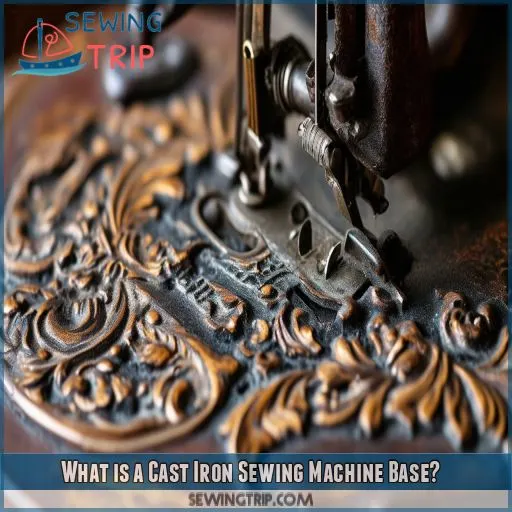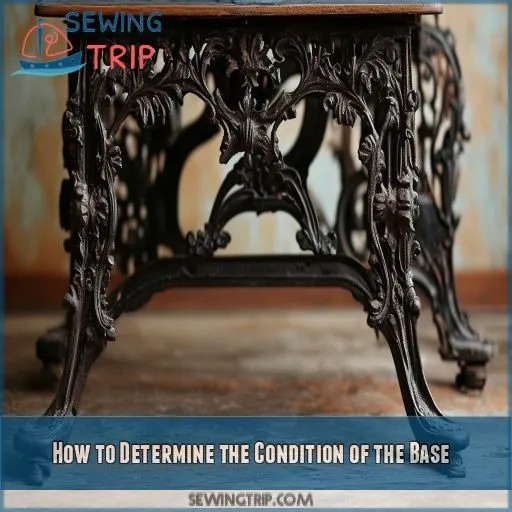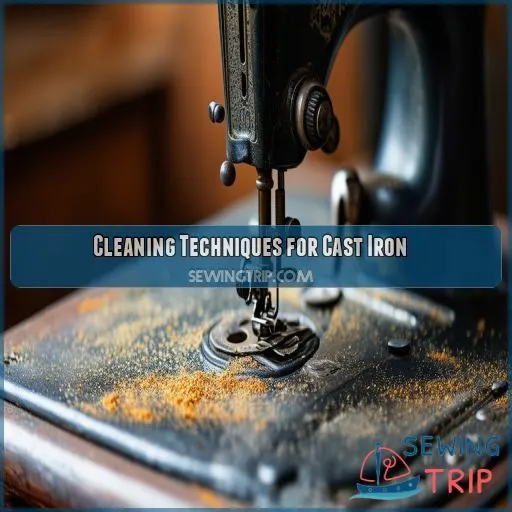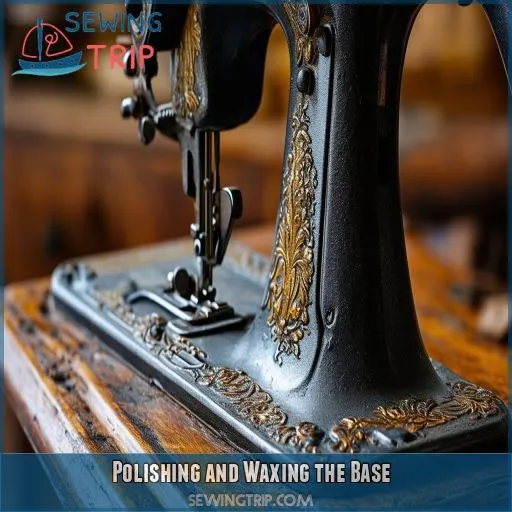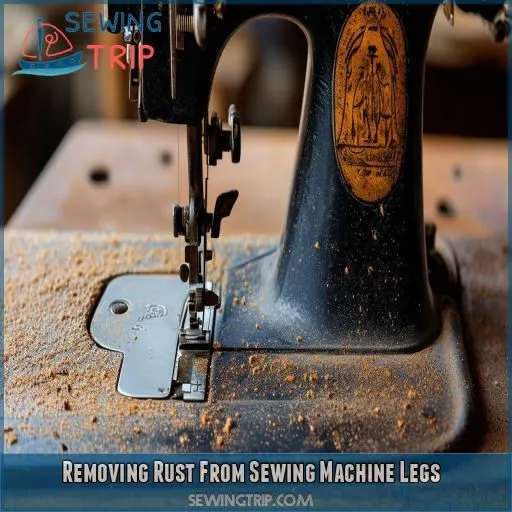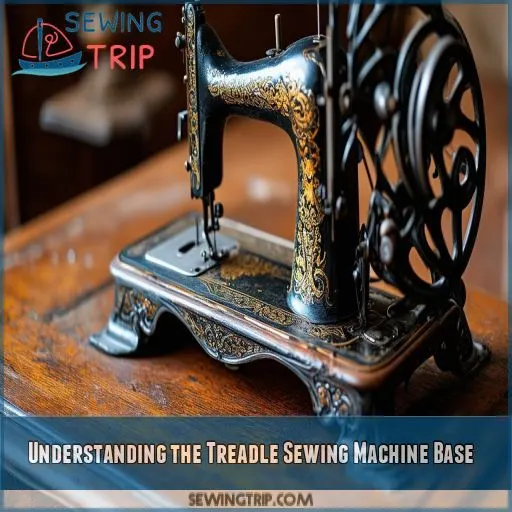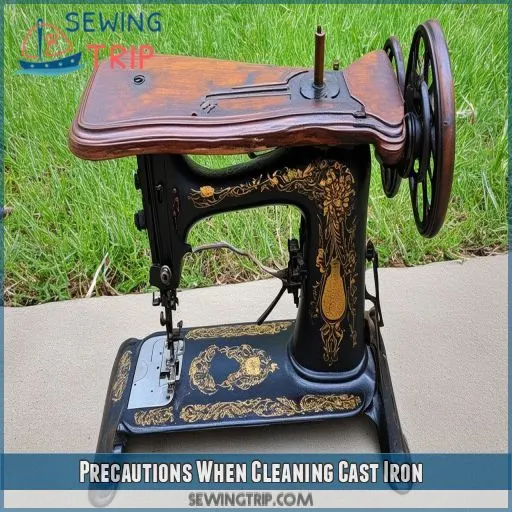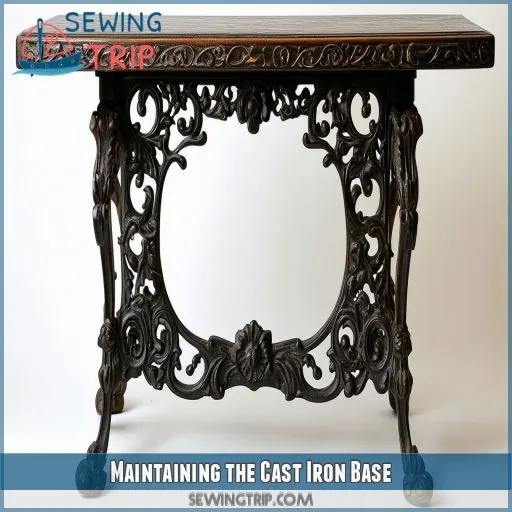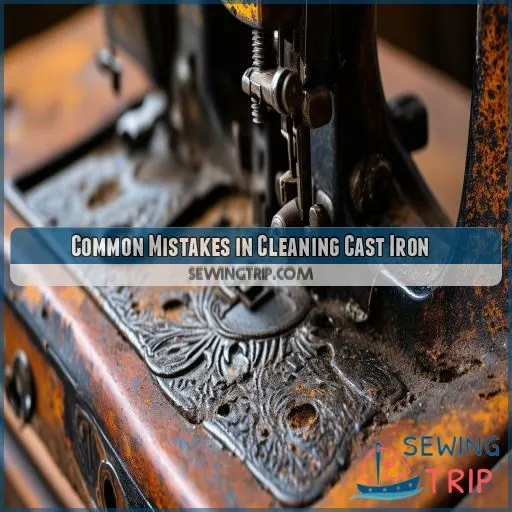This site is supported by our readers. We may earn a commission, at no cost to you, if you purchase through links.
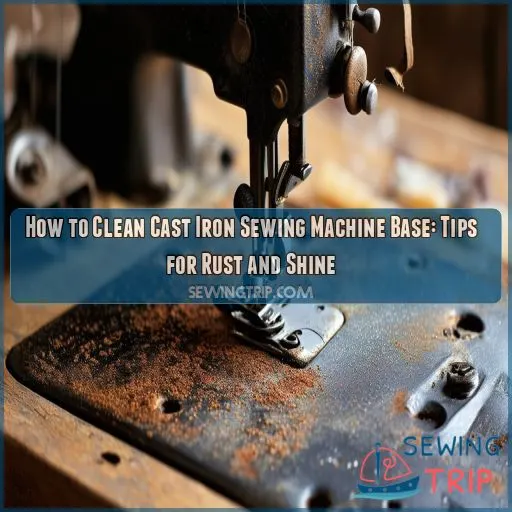
We’ll walk you through assessing its condition, tackling rust with effective tools like steel wool, vinegar, and wire brushes, and finishing with polishing and waxing for a brilliant shine.
Our professional tips ensure your cast iron base remains pristine without damage.
Read on for precise, actionable steps to restore your sewing machine’s former glory.
Table Of Contents
- Key Takeaways
- How to Clean Cast Iron Sewing Machine Base?
- What is a Cast Iron Sewing Machine Base?
- How to Determine the Condition of the Base
- Cleaning Techniques for Cast Iron
- Polishing and Waxing the Base
- Removing Rust From Sewing Machine Legs
- Understanding the Treadle Sewing Machine Base
- Precautions When Cleaning Cast Iron
- Maintaining the Cast Iron Base
- Common Mistakes in Cleaning Cast Iron
- Frequently Asked Questions (FAQs)
- Conclusion
Key Takeaways
- Cast iron sewing machine bases are sturdy, intricate foundations for vintage sewing machines. They showcase the craftsmanship of that era with ornate designs and durable construction.
- To clean a cast iron sewing machine base, start by using steel wool or scouring pads to gently remove surface rust. Dishwashing detergent combined with wire brushes can effectively clean tougher areas, while vinegar can help break down stubborn rust and grime.
- To polish and wax your cast iron sewing machine base, start with a quality carnauba wax product. Apply a small amount of the wax using a clean, soft cloth. Use circular buffing motions to evenly distribute the wax. Once applied, allow it to set, then buff off the excess.
- To maintain your cast iron sewing machine base, protect its historical fingerprints and patina. Think of it like seasoning a cast iron skillet. Regular oiling helps. A light coat of sewing machine oil creates a barrier against rust. Wipe off excess oil, ensuring a thin, even layer.
How to Clean Cast Iron Sewing Machine Base?
To clean a cast iron sewing machine base, start by checking for rust, pitting, and original patina.
Use steel wool or a scouring pad to remove surface rust, followed by dishwashing detergent for tougher spots.
A wire brush and vinegar can tackle stubborn grime.
Polish with carnauba wax, applying it with a soft cloth and buffing in circular motions.
For rust on the legs, consider abrasive blasting or electrolysis for thorough removal.
Always rinse and dry the base carefully, avoiding harsh chemicals to preserve its vintage charm.
Maintain it well, and you’ll keep that beautiful craftsmanship shining.
Want more tips? Stick around.
What is a Cast Iron Sewing Machine Base?
A cast iron sewing machine base is a sturdy, intricate foundation for vintage sewing machines. Originating in the late 19th and early 20th centuries, these bases showcase the craftsmanship of that era with ornate designs and durable construction.
Cast iron, known for its strength, provides a stable platform and decorative potential, making it both functional and attractive.
Identifying different types of cast iron bases and understanding their history can enhance your appreciation and inform your approach to cleaning and maintaining these charming relics.
How to Determine the Condition of the Base
Assessing the condition of your cast iron sewing machine base is crucial before cleaning. Here’s how you can do it:
- Corrosion Assessment: Check for rust and pitting on the surface.
- Patina Preservation: Identify areas where the original patina remains, as this can add character.
- Rust Prevention: Look for signs of protective coatings or paint fading.
- Oil Lubrication & Moisture Management: Ensure joints move smoothly and there’s no excess moisture, which can exacerbate rust formation.
Cleaning Techniques for Cast Iron
To clean a cast iron sewing machine base, start by using steel wool or scouring pads to gently remove surface rust. Dishwashing detergent combined with wire brushes can effectively clean tougher areas, while vinegar can help break down stubborn rust and grime.
Steel Wool or Scouring Pads
Steel wool or scouring pads can effectively remove stubborn rust and grime from cast iron sewing machine bases. Gently scrub the surface in circular motions, taking care not to damage any delicate finishes. Rinse thoroughly and dry completely to prevent further corrosion.
Dishwashing Detergent
After using steel wool, apply dishwashing detergent for cleaning cast iron. Follow these steps:
- Mix detergent with warm water.
- Use a soft cloth to scrub rust and grime.
- Rinse thoroughly, then dry completely to prevent further rust.
Wire Brushes
Use wire brushes to tackle rust on your cast iron sewing machine base. Choose types based on bristle stiffness for targeted cleaning. Apply elbow grease, ensuring effective rust removal and surface preparation. This method, using metal brushes, will restore shine and maintain your base’s integrity.
Vinegar
Vinegar is a powerful cleaning agent for cast iron, but use caution. It can remove rust and grime, but may also strip protective coatings. Consider safer alternatives like:
- Baking soda and water
- Lemon juice and salt
- Vegetable oil and salt
- Mild dish soap and water
Polishing and Waxing the Base
To polish and wax your cast iron sewing machine base, start with a quality carnauba wax product. Apply a small amount of the wax using a clean, soft cloth.
Use circular buffing motions to evenly distribute the wax. Once applied, allow it to set, then buff off the excess. This polishing technique not only enhances shine but also adds a protective coating.
For hard-to-reach areas, you might use a soft brush. Ensure every spot gets attention for consistent protection.
Removing Rust From Sewing Machine Legs
Removing rust from sewing machine legs takes patience and the right tools. Here’s how:
- Abrasive Blasting: Use abrasive blasting for thorough rust removal.
- Electrolysis: Employ an electrolysis setup with washing soda to gently eliminate rust.
- Phosphoric Acid: Treat with phosphoric acid or EvapoRust for rust conversion.
Always rinse and dry thoroughly after each method. For smaller areas, apply naval jelly and scrub efficiently. With these techniques, your sewing machine legs will regain their former glory.
Understanding the Treadle Sewing Machine Base
When it comes to treadle sewing machines, the base design is a crucial component. These vintage machines were powered by a foot pedal that drove the flywheel, allowing seamstresses to sew without electricity.
Understanding the history and mechanics of the treadle base can help you properly maintain it. Adjust the pedal tension as needed, and follow a regular maintenance schedule to keep the base in top shape.
Embrace the machine’s natural patina – it’s part of the charm! With a little care, you can preserve the treadle’s timeless elegance.
Precautions When Cleaning Cast Iron
You need to dry cast iron thoroughly to prevent rust. Don’t forget to avoid harsh chemicals and use a protective coating for an enduring shine.
Proper Drying Techniques
Drying your cast iron sewing machine base properly is crucial to avoid rust. Follow these steps:
- Immediate Drying: Wipe it down thoroughly with a soft cloth right after cleaning.
- Iron Seasoning: Apply a thin layer of oil to prevent moisture.
- Proper Storage: Store in a dry place, ensuring no direct contact with damp surfaces.
Keep rust at bay!
Avoiding Harsh Chemicals
Steer clear of harsh degreasing solvents, as they can strip the delicate patina protection on your cast iron sewing machine base. Instead, opt for natural alternatives like vinegar or baking soda – they’re eco-friendly and gentle on sensitive surfaces. With a little extra care, you can keep your base looking its best.
Protective Coating
After cleaning, consider applying a protective coating to preserve the machine’s patina and prevent rust. Opt for:
- Carnauba wax: Buff it in for a durable sheen.
- Rust-inhibiting spray: Light and even coats work best.
- Clear enamel: Ensures long-term protection, especially in humid environments.
These steps help maintain the polish and longevity of your cast iron base.
Maintaining the Cast Iron Base
To maintain your cast iron sewing machine base, protect its historical fingerprints and patina. Think of it like seasoning a cast iron skillet. Regular oiling helps. A light coat of sewing machine oil creates a barrier against rust. Wipe off excess oil, ensuring a thin, even layer.
| Maintenance Task | Frequency |
|---|---|
| Oiling | Monthly |
| Cleaning | Bi-monthly |
| Rust Inspection | Quarterly |
| Protective Coating | Annually |
| Wipe Down | After Use |
Proper maintenance preserves your machine’s charm.
Common Mistakes in Cleaning Cast Iron
Avoid common mistakes when cleaning your cast iron sewing machine base. Steer clear of abrasive cleaners like steel wool or scouring pads – they can damage the delicate surface. Harsh chemicals like bleach or ammonia may seem tempting for rust removal, but they can strip the protective coating and lead to further corrosion. Instead, opt for gentler solutions like vinegar or mild dish soap. And be sure to thoroughly dry the base after cleaning to prevent new rust from forming. With the right approach, you can keep your cast iron base looking its best.
- Steer clear of abrasive cleaners
- Avoid harsh chemicals for rust removal
- Ensure thorough drying after cleaning
Frequently Asked Questions (FAQs)
How do you clean a cast iron stand?
To clean that cast iron stand, roll up your sleeves and get to work! First, give it a good scrub with some soapy water, then buff it up with a touch of elbow grease. Voila – good as new!
How do you remove rust from old sewing machine legs?
To remove rust from old sewing machine legs, use a wire brush to scrub off loose rust, then apply a rust converter or remover. Wipe clean, prime, and paint to protect against future rust.
How to clean the base of a treadle sewing machine?
To clean the base of a treadle sewing machine, use household soap and warm water, scrub gently with a soft cloth, rinse with a damp cloth, dry thoroughly, and apply a light coat of sewing machine oil.
Is it OK to clean cast iron with vinegar?
Ah, the cast-iron sewing machine base – a canvas waiting to be revived! While vinegar can work wonders, tread carefully, my friend. A gentle touch with mild soap and water may be your safest bet for a gleaming restoration.
Can vinegar be used to clean cast iron?
Yes, you can use vinegar to clean cast iron. Mix equal parts vinegar and water, soak the part briefly, then scrub off rust with a brush. Rinse thoroughly and dry immediately to prevent rust.
How often should I clean the machine base?
You should clean the sewing machine base every few months or whenever you notice dust or grime buildup. Regular maintenance helps preserve its condition and ensures smooth operation.
What are the best lubricants for cast iron?
You’ll be over the moon with the performance of sewing machine oil – it’s the bee’s knees for keeping your cast iron base in tip-top shape. Just apply a few drops and watch it glide effortlessly.
Can I repaint a cast iron sewing base myself?
Yes, you can repaint a cast iron sewing machine base yourself. Prepare by cleaning the surface, removing rust, and applying a primer. Finally, use quality spray paint for a smooth, durable finish.
Are there specific cleaning products to avoid?
Avoid harsh or abrasive cleaners, bleach, and ammonia-based products as they can damage the machine’s finish. Stick to mild soaps, warm water, and sewing machine oil for safe and effective cleaning of your cast iron sewing base.
Conclusion
Imagine your trusty sewing machine as a treasured family heirloom, deserving of the utmost care. By following the detailed steps outlined in this guide, you can transform your cast iron sewing machine base into a gleaming masterpiece.
From tackling stubborn rust to achieving a brilliant shine, the techniques shared here will ensure your how to clean the cast iron sewing machine base remains pristine for years to come.
With a little elbow grease and the right approach, your sewing machine will reclaim its former glory, ready to inspire generations of crafters.

